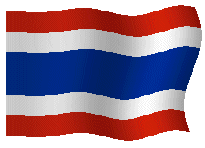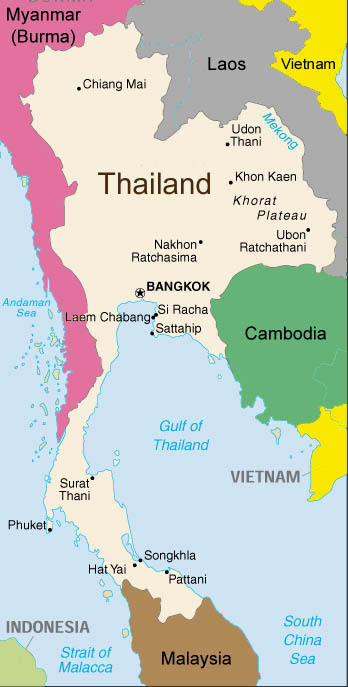|
Introduction
The Thai kingdom, established in the mid-14th century, was
known as Siam until 1939 when it received its current name of the Kingdom
of Thailand. Situated in Southeast Asia, Thailand is a predominantly
Buddhist kingdom covering an area of 510,000 sq. km (slightly more than
twice the size of Wyoming). Shaped like an elephant's head, it is bordered
by Myanmar (Burma) to its north and west, Laos on its northeast, Cambodia
and the Gulf of Thailand on its southeast and by Malaysia and Myanmar on
its south and southwest, respectively. The country is rich in tradition,
archetecture, fine food, natural resources and tropical flora and fauna.
Statistic
Country name
Kingdom of Thailand
Location
Southeastern Asia, bordering the Andaman Sea and the Gulf of Thailand,
southeast of Burma
Area
514,000 sq km (slightly more than twice the size of Wyoming)
Coastline
3,219 km
Climate
Thailand has a moist, tropical climate, influenced chiefly by monsoon
winds that vary in direction according to the season. In spring and summer
the winds are moisture laden and temperatures are higher, ranging from 78
to 98 degrees F, while in the remainder of the year the temperature range
is from 56 to 92 F.
Elevation extremes
lowest point: Gulf of Thailand 0 m
highest point: Doi Inthanon 2,576 m
Natural resources
tin, rubber, natural gas, tungsten, tantalum, various gem stones, timber,
lead, fish, gypsum, lignite, fluorite, arable land
Population
Approx. 61 million
Ethnic groups
Thai 75%, Chinese 14%, other 11%
Religions
Buddhism 95%, Muslim 3.8%, Christianity 0.5%, Hinduism 0.1%, other 0.6%
(1991)
Languages
Thai, English (secondary language of the elite), ethnic and regional
dialects
Government
constitutional monarchy
Capital
Bangkok
Geography
x |
|
Thailand lies at the heart of southeast
Asia, in the western section of the Indochinese Peninsula. The country can
be divided into four geographic regions:
1. Northwest: Mountainous, alternating with
plains along narrow valleys. The highest mountain in Thailand is Doi
Inthanon (2,565 m. or 8,417 ft.) in the Thanon Thongchai range of the
province of Chiang Mai.
2. The Central Plain: A vast plain made up of
Chao Phraya River basin and several other rivers, it is the prime food
producing region and home of Bangkok Thailand's capital and largest city.
The land is elevated only a little higher than mean sea level. As it has
fertile soil and water, the Central Plain has become the agricultural,
economic and political center of the country today.
3. The Khorat Plateau: This is in the
northeastern part of Thailand and makes up about one-third of the
country's land area. Mountain ranges separate the plateau from central
Thailand to the west and Cambodia to the south. The Mekong River forms the
region's northern and eastern boundaries. Generally, the area is dry with
sandy soil that makes poor farmland.
4. The Southern Peninsula: Thailand's
Southern Peninsula forms the northern part of the Malay Peninsula and
begins from the Kra Isthmus down to the Malay border. The area is made up
of long stretches of mountain ranges with narrow strips of land on the
Gulf of Thailand and the Andamam Sea coasts. The long coastlines offer
scenic attractions, particularly on the beaches of Surat Thani, Songkhla,
Phangnga, Phuket, Trang and Satun.
Natural Resources
Among the known mineral deposits are coal, gold, lead, tin, tungsten,
manganese, zinc, and precious stones. In addition, the country has many
large forests that produce teak for export. The rich alluvial soil along
the Chao Phraya and other rivers of the Central Plain form a rich
agricultural zone where rice and tropical fruits are grown.
Flora and Fauna
Jungles and swamps, scattered through the coastal areas of Thailand, have
extensive stands of tropical trees, including mangrove, rattan, ironwood,
ebony, and rosewood. The upland areas are also heavily wooded in teak and
oak. In addition, a wide variety of tropical plants and fruit trees,
including orchid, gardenia, hibiscus, banana, mango, and coconut, grow in
Thailand. Elephants, widely used as beasts of burden, are abundant. Other
large animals include the rhinoceros, tiger, leopard, water buffalo,
gibbon and Siamese cat. Thailand has more than 50 species of snakes,
including several poisonous varieties. Crocodiles are numerous, as are
various species of fishes
Architecture
Thailand has thousands of monasteries, temples and shrines. Bangkok,
alone, has over four hundred Buddhist buildings such as Wat Traimit, Wat
Arun -- the Temple of Dawn, which is the tallest religious building in the
capital. Other architecture of note is the Grand Palace and the Temple of
the Emerald Buddha.
Points of Interest
Bangkok
Bangkok or Krung Threp (means "City of Angeles") is the political,
commercial and cultural capital of Thailand. It lies on the east side of
the Chao Phraya River in the Central Plain. Must sees include Wat Phra
Kaew and the Grand Palace, Wat Pho and Wat Traimit (Temple of the Golden
Buddha) which houses the impressive 3 meter tall, 5 1/2-ton solid-gold
Buddha. Other sights to see include the Wat Sai floating market in
Thonburi, a boat trip through the city's extensive network of canals (klongs)
and the renowned Oriental Hotel (rated number one in the world when I
stayed there).
Ayuthaya
The temple ruins at Ayuthaya, 86 km north of Bangkok, date from the most
flourishing period of Thai history (1350 - 1767 AD). Thirty-three kings of
various Siamese dynasties reigned here until the city was conquered by the
Burmese in 1767. By the end of the 17th century, Ayuthaya's population had
reached one million and virtually all visiting foreigners claimed it to be
the most illustrious city they had ever seen. Ayuthaya's scattered temples
and ruins have been declared a World Heritage Site. The list includes the
14th century Wat Phra Si Sanphet, the largest in Ayuthaya, which once
contained a 16m standing Buddha that was covered in gold. The
16th-century, fortress-like Wat Phra Meru boasts an impressive carved
wooden ceiling, a splendid Ayuthaya-era 6 meter high crowned sitting
Buddha and a 1300-year-old green-stone Buddha from Ceylon. Wat Phra Chao
Phanan Choeng was built in the early 14th century (possibly by Khmers). It
contains a highly revered 19 meter Buddha image from which the wat derives
its name.
Chiang Mai
Thailand's second-largest city and the gateway to the country's north was
founded in 1296. There are 300 wats, including Wat Chiang Man (home of the
1800-year-old 10-cm-high Crystal Buddha), Wat Phra and Wat Chedi Luang.
The 1676 meter high Doi Suthep, topped by one of Thailand's holiest wats,
offers a dramatic view of the city. Modern Chiang Mai is well-known for
its restaurants and a starting point for mountain treks.
Phuket
Dubbed the "Pearl of the South", Phuket is Thailand's largest island and
lies in the Andaman Sea off the south-western coast. It retains a distinct
atmosphere derived from its Chinese, Portuguese and native Chao Naam
sea-faring cultures. It has good beaches, tropical vegetation and a
relaxed atmosphere. |


